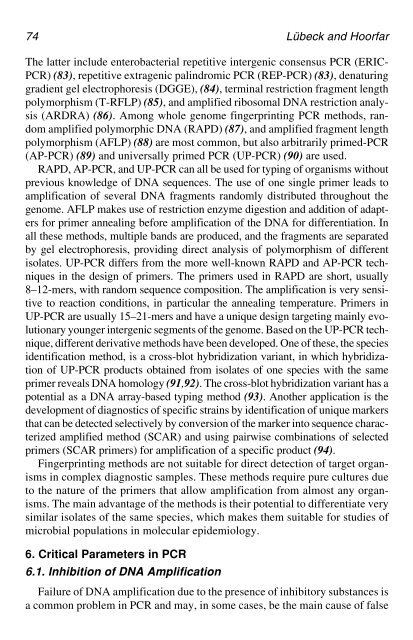PCR Detection of Microbial Pathogens PCR Detection of Microbial ...
PCR Detection of Microbial Pathogens PCR Detection of Microbial ...
PCR Detection of Microbial Pathogens PCR Detection of Microbial ...
You also want an ePaper? Increase the reach of your titles
YUMPU automatically turns print PDFs into web optimized ePapers that Google loves.
74 Lübeck and Hoorfar<br />
The latter include enterobacterial repetitive intergenic consensus <strong>PCR</strong> (ERIC-<br />
<strong>PCR</strong>) (83), repetitive extragenic palindromic <strong>PCR</strong> (REP-<strong>PCR</strong>) (83), denaturing<br />
gradient gel electrophoresis (DGGE), (84), terminal restriction fragment length<br />
polymorphism (T-RFLP) (85), and amplified ribosomal DNA restriction analysis<br />
(ARDRA) (86). Among whole genome fingerprinting <strong>PCR</strong> methods, random<br />
amplified polymorphic DNA (RAPD) (87), and amplified fragment length<br />
polymorphism (AFLP) (88) are most common, but also arbitrarily primed-<strong>PCR</strong><br />
(AP-<strong>PCR</strong>) (89) and universally primed <strong>PCR</strong> (UP-<strong>PCR</strong>) (90) are used.<br />
RAPD, AP-<strong>PCR</strong>, and UP-<strong>PCR</strong> can all be used for typing <strong>of</strong> organisms without<br />
previous knowledge <strong>of</strong> DNA sequences. The use <strong>of</strong> one single primer leads to<br />
amplification <strong>of</strong> several DNA fragments randomly distributed throughout the<br />
genome. AFLP makes use <strong>of</strong> restriction enzyme digestion and addition <strong>of</strong> adapters<br />
for primer annealing before amplification <strong>of</strong> the DNA for differentiation. In<br />
all these methods, multiple bands are produced, and the fragments are separated<br />
by gel electrophoresis, providing direct analysis <strong>of</strong> polymorphism <strong>of</strong> different<br />
isolates. UP-<strong>PCR</strong> differs from the more well-known RAPD and AP-<strong>PCR</strong> techniques<br />
in the design <strong>of</strong> primers. The primers used in RAPD are short, usually<br />
8–12-mers, with random sequence composition. The amplification is very sensitive<br />
to reaction conditions, in particular the annealing temperature. Primers in<br />
UP-<strong>PCR</strong> are usually 15–21-mers and have a unique design targeting mainly evolutionary<br />
younger intergenic segments <strong>of</strong> the genome. Based on the UP-<strong>PCR</strong> technique,<br />
different derivative methods have been developed. One <strong>of</strong> these, the species<br />
identification method, is a cross-blot hybridization variant, in which hybridization<br />
<strong>of</strong> UP-<strong>PCR</strong> products obtained from isolates <strong>of</strong> one species with the same<br />
primer reveals DNA homology (91,92). The cross-blot hybridization variant has a<br />
potential as a DNA array-based typing method (93). Another application is the<br />
development <strong>of</strong> diagnostics <strong>of</strong> specific strains by identification <strong>of</strong> unique markers<br />
that can be detected selectively by conversion <strong>of</strong> the marker into sequence characterized<br />
amplified method (SCAR) and using pairwise combinations <strong>of</strong> selected<br />
primers (SCAR primers) for amplification <strong>of</strong> a specific product (94).<br />
Fingerprinting methods are not suitable for direct detection <strong>of</strong> target organisms<br />
in complex diagnostic samples. These methods require pure cultures due<br />
to the nature <strong>of</strong> the primers that allow amplification from almost any organisms.<br />
The main advantage <strong>of</strong> the methods is their potential to differentiate very<br />
similar isolates <strong>of</strong> the same species, which makes them suitable for studies <strong>of</strong><br />
microbial populations in molecular epidemiology.<br />
6. Critical Parameters in <strong>PCR</strong><br />
6.1. Inhibition <strong>of</strong> DNA Amplification<br />
Failure <strong>of</strong> DNA amplification due to the presence <strong>of</strong> inhibitory substances is<br />
a common problem in <strong>PCR</strong> and may, in some cases, be the main cause <strong>of</strong> false






